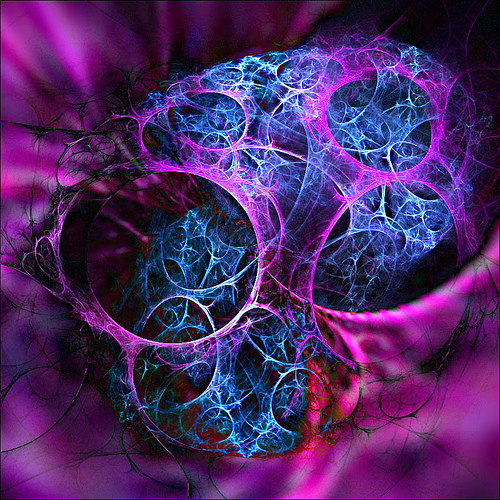Frost faculty composers in the spotlight at Festival Miami
“Form and Fractures” was the thematic thread for a diverse Festival Miami program of works by Frost School of Music faculty composers Tuesday night at Gusman Concert Hall. The often-quirky menu of nine scores produced its share of highs and lows.
On the down side count the premiere of Lawrence W. Moore’s Beautiful Synchronicities, a pretentious combination of video patterns of molecules and atoms, soprano narration and audio playback and distortion of the narrator’s speaking and singing voice. The film is distinguished mostly by sudden bursts of color and light, recalling an earlier psychedelic era. A buzz and rhythm on the electronic soundtrack suggests pop and rap music while the heavy-handed narration about the meaning of molecular elements to the complexity of life is subjected to electronic exaggeration. Only when the singer bursts into a wordless chant (sometimes transformed into a duet by the computerized audio) does Moore’s work briefly become hypnotic, suggesting what the piece could have been. Liza Seigido was the hard-working protagonist with the thankless task of breathing life into this sterile concoction.
Colby Leider’s Song was a pleasantly innocuous modernist take on Renaissance modes. Scored for two recorders and cornamuse (or viol recorder), this elegy makes easy listening without rising to distinction.
Charles Mason’s Metaman, a more subtle and artful fusion of sound and video, provided one of the high points of the concert. A collaboration with video artist Sheri Wills, the score fuses solo violin with electronics while the video of landscapes and roadways eventually engulfs the stage and the soloist. The virtuosic solo violin part is mixed with both live acoustic audio and samplings of recordings by Karen Bentley Pollick, the violinist who commissioned the work. Mason’s rapid-fire score is an intelligent mating of contemporary minimalism and Paganini on steroids, finessed with considerable wit. Glenn Basham was in prime form for the glittering solo role.
Juan Chattah’s Tango Suite No.2 was the evening’s crowd pleaser and for good reason. An unabashedly tuneful confection, the three-movement piece explores the evolution of tango from the sensuous dance tunes of the early 1900’s to the jazzy, astringent innovations of Astor Piazzolla’s Tango Nuevo from the 50’s and 60’s. Chattah’s gracious instrumental writing was essayed with pizzazz by the Bergonzi Quartet, bassist Brian Powell, the composer at the piano and a fiery star turn by Miguel Arrabal on bandoneon. A great melodist, Chattah never allows his populist instincts to compromise the color and imagination of his instrumental flights.
Despite claiming to represent the struggle of the individual against fate, Scott Stinson’s Rage Against the Machine is a surprisingly charming vignette, ingenuously crafted for four clarinets. A likeable mix of jazzy riffs and thorny Hindemith-style counterpoint, the piece provided a field day for Margaret Donaghue Flavin’s Miami Clarinet Quintet.
John D. Stewart’s Lawrence Fantasy, dedicated to composer Bernard Rands for his seventieth birthday, is a series of vocal miniatures to texts by D.H. Lawrence. It is unfortunate that the vignettes are so brief because Stewart exhibits the lyric gift and idiomatic vocal writing worthy of a Samuel Barber or John Harbison. S. Mark Aliapoulios was the warm-voiced baritone soloist with nearly flawless diction. The combination of violin, cello and piano accompaniment adds poetic resonance to this appealing cycle.
The bluesy, mellow saxophone of Carlos Averhoff was the raison d’être for Raul Murciano’s arrangement of Ernesto Lecuona’s Siboney, Geraldo Aguillon’s flashy violin solo adding spice.
Somewhere in the middle of the qualitative scale was Lansing McLoskey’s The Madding Crowd, an overlong brass quintet. An eerily evocative trumpet solo in the manner of Copland’s Quiet City (skillfully assayed by Leslie Scarpino) and a jazz-infused tuba romp were the high points of a partly improvised score that became wearying with its repetitive ominous fanfares.
Dennis Kam’s Three Antiphonal Fanfares were scattered throughout the concert. After an initially bracing fusion of a traditional festive fanfare with the spatial music of Henry Brant, the remaining two fanfares seemed to be the same piece with some additional antiphonal window dressing.
Posted in Performances
Leave a Comment
Wed Oct 13, 2010
at 10:11 am
No Comments







